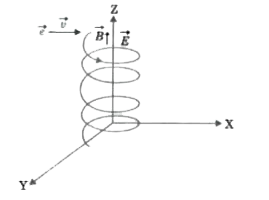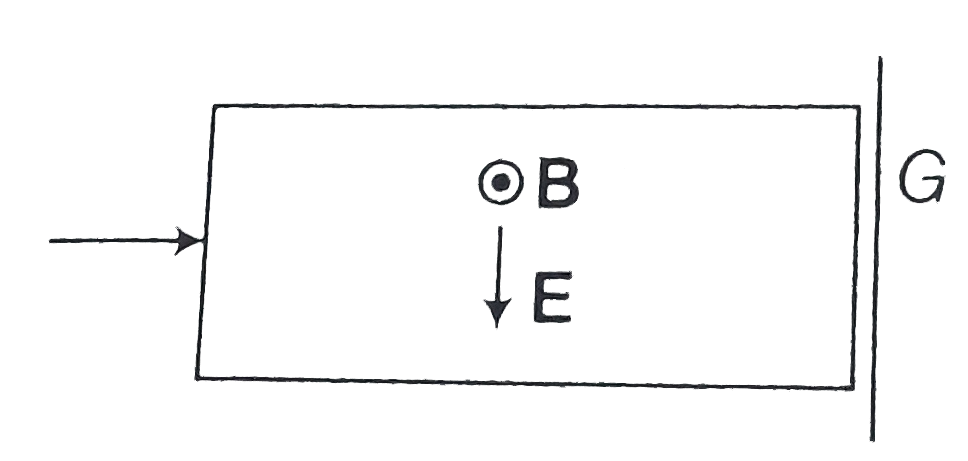An electron enters with a velocity →v=v0ˆi into a cubical region (faces parallel to coordinate planes) in which there are uniform electric and magnetic fields. The orbit of the electron is found to spiral down inside the cube in plane parallel to the x-y plane. Suggest a configuration of fields →E and →B that can lead to it.
Given, velocity of the electron, →v=v0ˆi , which means it is moving along X-axis before entering the cubical region. The spiral motion of the electron is due to the magnetic field (→B) acting perpendicularly to its motion. This means that the magnetic field is either along Y-axis or Z-axis. But it is mentioned that the motion is spiral down inside the cube in a plane parallel tox.y plane. This means that both the electric field and magnetic field are acting along the Z-axis.

Topper's Solved these Questions
- BOOK - MODERN PUBLICATIONCHAPTER - MOVING CHARGES AND MAGNETISMEXERCISE - Higher Order Thinking Skills & Advanced Level10videos
MOVING CHARGES AND MAGNETISM
- BOOK - MODERN PUBLICATIONCHAPTER - MOVING CHARGES AND MAGNETISMEXERCISE - Revision Exercises (Very Short Answer Questions )59videos
MOVING CHARGES AND MAGNETISM
- BOOK - MODERN PUBLICATIONCHAPTER - MOVING CHARGES AND MAGNETISMEXERCISE - NCERT (Exemplar Problems ) (Very Short Answer Type Questions )5videos
MOVING CHARGES AND MAGNETISM
- BOOK - MODERN PUBLICATIONCHAPTER - MAGNETISM AND MATTEREXERCISE - CHAPTER PRACTICE TEST FOR BOARD EXAMINATION16videos
MAGNETISM AND MATTER
- BOOK - MODERN PUBLICATIONCHAPTER - NUCLEIEXERCISE - CHAPTER PRACTICE TEST FOR BOARD EXAMINATION15videos
NUCLEI
Similar Questions
What is the net flux of the uniform electric field of Q.15 thorugh a cube of side 20cm oriented so that its faces are parallel to the co-ordinate planes ?
View SolutionWhat is the net flux of the uniform electric field of the above question through a cube of side 20 cm oriented so that its faces are parallel to the coordinate planes?
View Solution
Knowledge Check
- Question 1 - Select One or More
A cubical region of space is filled with some uniform electric and magnetic fields. An electron enters the cube across one of its faces with velocity →v and a positron enters via opposite face with velocity −→v. At this instant,
Athe electric forces on both the particles cause identical accelerationsBthe magnetic forces on both the particles cause equal accelerationCboth particles gain or loose energy at the same rateDthe motion of the centre of mass (CM) is determined by →B alone - Question 2 - Select One
A cubical region of space is filled with some uniform electric and magnetic field. An electron enters the cube across one of its faces with velocity v and a positron enters via opposite face with velocity −v. At this instant, which one of the following is not correct?
AThe electric forces on both the particles cause identical acceleration.BThe magnetic forces on both the particles cause equal acceleration.CBoth particles gain or loose energy at the same rate.DThe motion of the centre of mass is determined by B alone. - Question 3 - Select One
An electron is moving with an initial velocity →v=v0ˆi and is in a magnetic field →B=→B0ˆj. Then its de-Broglie wavelength
Aremains constantBincreases with timeCdecreases with timeDincreases and decreases periodically.
A 10eV electron is circulating in a plane at right angles to a uniform field at magnetic induction 10−4Wb/m2 (=1.0 gauss). The orbital radius of the electron is
View SolutionA uniform electric field →E exists in a region parallel to Y-axis. How much work will be done on a charge q in displacing it in this field, parallel to x-z plane?
View SolutionA stream of electron and protons are directed towards a narrow slit in a screen the intervening region has a uniform electric field E vertically downwards and a unifrom magnetic field B out of the plane of the as shown then
 View Solution
View SolutionA charged particle moving with a uniform velocity →v enters a region where uniform electric and magnetic fields →E and →B are present. It passes through the region without any change in its velocity. What can we conclude about the (i) relative direction of →E, →V and →B? (ii) magnetic of →E and →B?
or
Find the condition under which the charged particle moving with different speeds in the presence of electric and magnetic field vectors can be used to select charged particles of a particular speeds.View SolutionAn electron is moving with an initial velocity →v=v0ˆi and is in a magnetic field →B=B0ˆj. Then it's de-Broglie wavelength
View Solution

